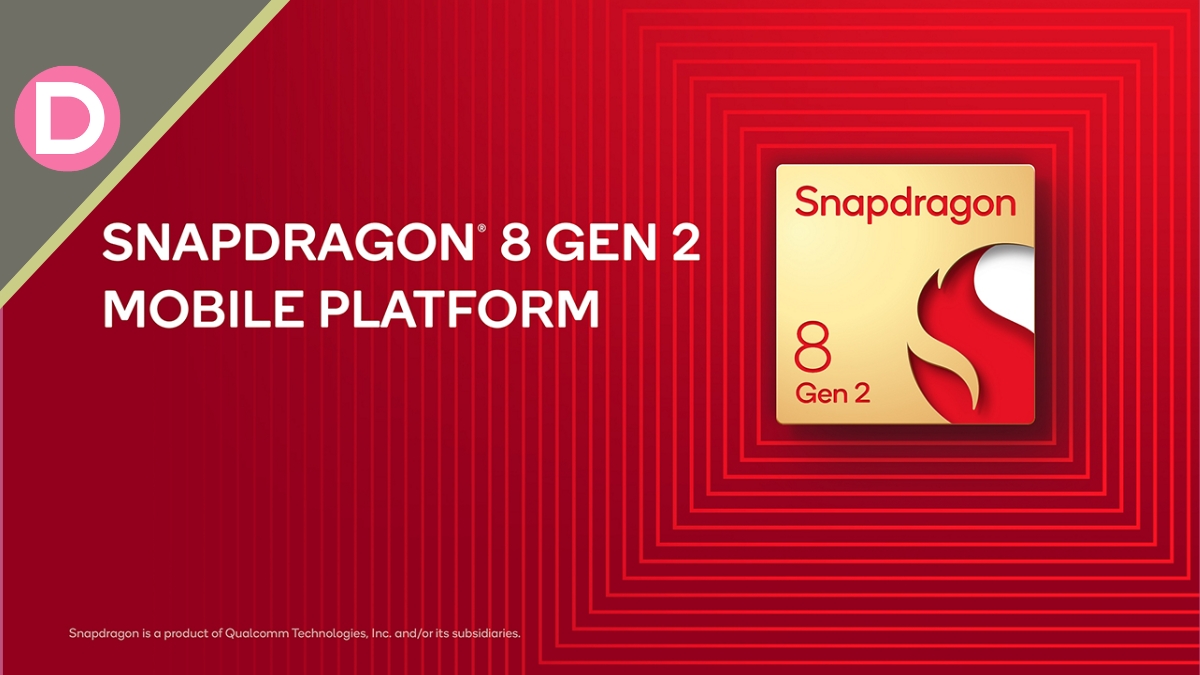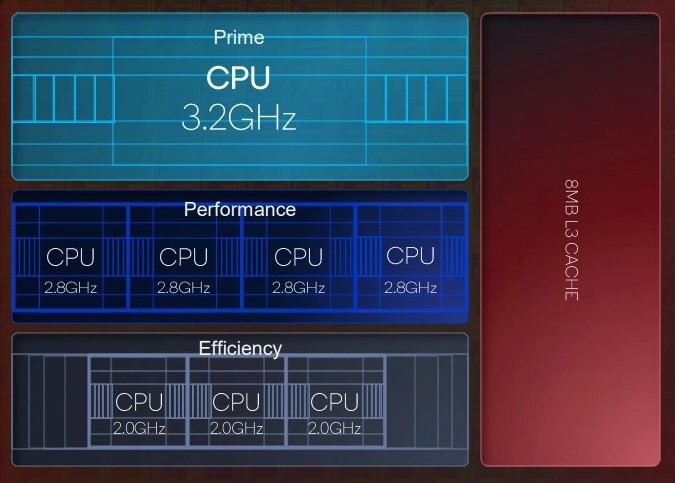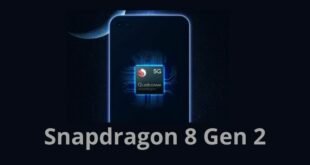After two long years of incompetent SOCs from Android, the Snapdragon 8+ Gen 1 broke the ice. It nearly beat Apple’s A16 Bionic. The 8+ Gen 1 wasn’t significantly different from the 8 Gen 1, but slightly modified clock speeds and a change in fabrication did the trick.
Qualcomm’s flagship chip for 2023 smartphones was announced a couple of months later. They predictably called it the 8 Gen 2. It brought massive improvements over the 8+ Gen 1 on paper. The new 8 Gen 2 has the 3.2 GHz Cortex X3 as its Prime Core. It has four performance cores clocked at 2.8 GHz and three efficiency cores clocked at 2 GHz.
The 1+4+3 arrangement should supposedly offer tremendous boosts to sustained performance and battery efficiency. The main reason why the 8 Gen 1 and Snapdragon 888 were such heating machines was that they used Samsung’s nodes.
The Samsung Foundry is notorious for chipsets that are poor with sustained performance. Since thermal management is lacking, the devices have terrible heating issues even in daily use. The hot chipsets also have comparatively worse efficiency per watt. This results in lower battery life.
Since people blamed the Samsung Node for the failures of the 8 Gen 1, it was quite a relief when Qualcomm decided to move to TSMC for their 8 Gen 2. The 8 Gen 2 uses TSMCs 4nm fabrication process. It’s way more efficient than before, and both the CPU and GPU trade blows with Apple’s A16 Bionic in terms of power efficiency.
The main question is whether the 8 Gen 2 has heating issues. In this article, we’ll try to answer whether the chip stays cooler than its predecessors. We will also determine the sustained performance and whether the chip lives up to the hype. Note that this article derives inputs from various sources and is strictly on paper.
Snapdragon 8 Gen 2 Benchmark
Antutu & Geekbench
The 8 Gen 2 does well on most benchmarking tools. It scores over 1.2 Million points on Antutu and sometimes crosses the 1.25 Million mark. It gets better since the score has good sustainability.
The 8 Gen 1 previously could reach 1 Million points when it was in a cool environment, but the scores plummeted even after the slightest push. Running multiple Antutu benchmarks back to back was impossible with the 8 Gen 1.
The chip would heavily lose its performance due to thermal throttling. To prevent disastrous overheating, it refused to perform the benchmark after a couple of rounds.
The average Antutu score of the 8 Gen 2 is estimated to be 1.2 Million after testing it on the X90 Pro Plus, IQOO 11, Nubia Red Magic 8 Pro, Xiaomi 13, and the Xiaomi 13 Pro.
Well-known reviewer Ershad from Trakin Tech English also reported similar findings. The 8 Gen 2 might score up to the 1.3 Million mark if tuned for performance.
The Vivo X90 Pro+ has a boost mode, where it runs the CPU and GPU at max clock speeds and aggressively pushes for high performance but leaves temperatures up in the air.
The phone performed well (peak), but sustainability did take a hit. The phone also reached a very high 50 degrees Celsius in temperature. Phones with better software tuning and better cooling chambers can perform better.
The 8 Gen 2 is significantly better than the 8+ Gen 1 in terms of CPU performance. The popular Geekbench tool scores over 1500 in single-core scores and breaks the 5000 mark in multi-core scores.
While still behind the A16 Bionic, the gap is now closed to the point where an actual difference in practical life cannot be noticed. The scores do sustain after multiple successive rounds, too.
Efficiency, power draw, and temperatures are a modest improvement from the 8 Gen 1 SOC.
Stability Tests
The arguably best method to check whether a chip has heating issues is running a series of 3D Mark tests. When comparing the stability scores of the 3D Mark Wild Life Extreme Stress test, the 8 Gen 2 blows the A16 out of the water and entirely runs away with a considerable lead.
The Best loop score averages 3700, and the lowest is 3300. Funnily enough, the lowest boot loop score of the 8 Gen 2 is close to the highest loop score of the A16. The stability scores are excellent, with 90%. The CPU stress test also does not show significant throttling under pressure.
GPU Tests
The GPU used on the 8 Gen 2 is incredibly efficient and has the best-sustained performance on any chip. It has excellent efficiency thanks to low power consumption and does not entirely throttle down to prevent heat.
The 8 Gen 2 is over 30% better in terms of stability and scores on extreme stress tests when compared to the 8 Gen 1. These scores are still initial, and many more devices will launch over time that might one-up them.
The GFX Bench Manhattan test at 1080P scores around 330 FPS, and the Manhattan 3.1 test delivers over 220 FPS, indicating that the GPU is relatively stable. 8 Gen 2 scores nearly 8500 on the Vulkan test on Geekbench 5.
Gaming
So far, we have seen reliable gaming tests of 8 Gen 2 phones playing popular titles such as Call of Duty, Apex Legends, and Genshin Impact. Genshin runs remarkably well with a good resolution and max frame rate settings.
Most games support the maximum 120 FPS frame rates with the highest graphic quality. It’s worth noting that the 8 Gen 2 supports Ray Tracing technology.
Ray Tracing is an advanced and hyper-realistic way of rendering light and shadows in a game for excellent graphics and better depth when gaming. This technology has not seen a debut yet, but we hope developers use this incredible feature.
It looks like the Snapdragon 8 Gen 2 has no heating Issue
All the existing data we have right now are from preliminary benchmarks and gaming tests. Popular phones like the X90 Pro Plus and Xiaomi 13, though very good, have not yet made it to India or the global markets.
The current tests run on Chinese variants, and the chip is relatively new. When the phones are globally released, we can expect to see even better gaming performance if developers take advantage of the horsepower.
Phones with active cooling will perform better than phones without it. For example, a properly tuned Xiaomi 13 Pro can beat the IQOO 11 since the IQOO lacks active cooling. On such phones, the overall performance might be worse, and slight heating may be observed in extreme situations.
When companies globally launch 8 Gen 2 phones, we will see better optimization, too. The golden standard for measuring heat is the 3D Mark Extreme test, which the 8 Gen 2 has passed with flying colors.
It is safe to theoretically conclude that the Snapdragon 8 Gen 2 does not have any problems with overheating in daily use. However, if the brand pushes for maximum performance without worrying about thermals, heating can be noticed in extreme scenarios when pushing the chip to the max.
We are eagerly awaiting more tests. The eventual global launches will give us an even better idea of the 8 Gen 2, which might perform better than it is now. We will keep you updated when there are more tests.




